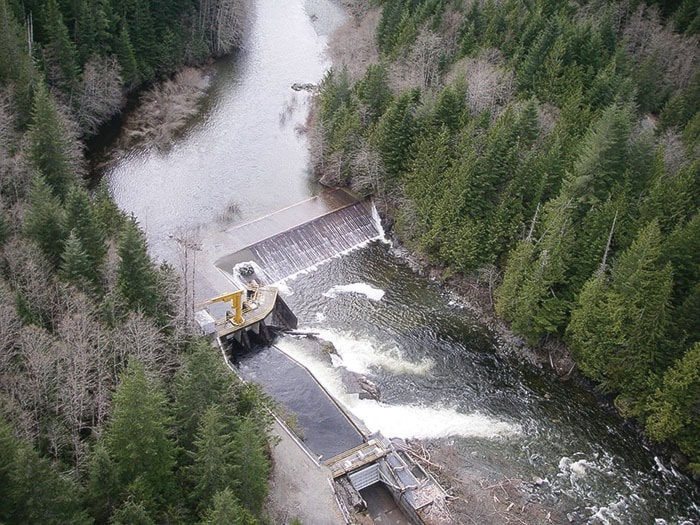BC Hydro filed an application last week to the BC Utilities Commission to remove their 60-year-old dam on the Salmon River.
The facility includes an eight-metre high rock-fill timber crib diversion dam, and a three kilometre canal which diverts water from the Salmon River through the canal to Brewster Lake and on to the Campbell River system for power generation. If all goes well the dam will be removed this summer, the company said in press release.
The dam and canal are in poor condition, though it’s the benefits to fish that ultimately led to Hydro’s proposed decision to remove the dam. The metal fish screen located within the concrete canal that’s intended to screen fish that enter it back into the Salmon River, does not have a high efficiency rate. And the fish ladder and the dam facility itself can be a barrier to adult fish passage when higher Salmon River flow rates are in place. Coho and steelhead do migrate past the facility but not at rates that could be provided with unhindered fish passage with the dam gone.
The dam is located about 58 km from the ocean, but it’s the 40 or so kilometres of upstream cool water and good habitat that is ideal for fish spawning and rearing.
“We started on an improved fish passage process with the community in 2007, including a Fish Passage Decision Framework process, and decided over time to improve upstream and downstream fish passage at the timber crib dam,” says BC Hydro spokesperson, Stephen Watson. “We were getting ready to do the upstream fish passage improvement works in 2016, but in advance of that, we wanted to get a full perspective of the upstream and downstream fish passage issues and costs, as well as needed dam and canal upgrades. We needed a full picture of the capital reinvestment costs. Once we had that cost number we compared it to the benefits of the diverted water for power generation and water use interests on the Campbell River system. BC Hydro’s planning of a comprehensive capital project for the Salmon River site, which was stopped in 2016, had an estimated cost of around $40 million. BC Hydro is of the opinion that the small economic benefit of the water diverted over time versus the $40 million improvement cost does not offset the continued environmental impacts of an inter-basin transfer from one river to another, nor the continued facility operating risks. It makes sense from a business case perspective to apply those capital funds to other BC Hydro projects around the province that would get better results.”
In early 2017, BC Hydro developed a cost estimate to decommission the Salmon River diversion facility at $14-15 million. The includes the removal of the dam and restoration of the river bed. Under this option the 3 kilometre long canal would stay in place indefinitely, and would be made safe from an environmental and public safety perspective. This provides for some significant cost savings. Watson says BC Hydro feels the physical footprint of the canal is of a low impact. A small wooden flume section of the canal that crosses Patterson Creek would be removed as well as the fish screen structure.
“To remove a dam, BC Hydro must submit an application to the BC Utilities Commission,” says Watson. “It took a lot of work to complete and were pleased to have it in. It’s great to see it submitted. If all goes well we hope to have BCUC approval to decommission the Salmon River diversion facility by the end of May. Concurrently, we are planning for site preparations, permitting, and procurement so the work can be completed within the fisheries summer work window. It’s a tight schedule. Our goal is to have unhindered fish passage for the coho run in fall 2017.”
To help in the success of their application, BC Hydro received an impressive 19 community letters of support ranging from First Nations, MLA’s, local governments, government fish agencies, and environmental and sport fishing groups.
“We have strong support within the community to remove the dam and restore unhindered fish passage both upstream and downstream,” says Watson. “We’ll keep people apprised on how the BCUC process may proceed.”
The regulatory process will also be posted on the BCUC web site.
In 2012, BC Hydro completed the decommissioning and remediation of the Heber River diversion facility, near Gold River.
